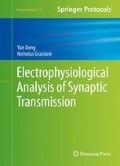Abstract
A burden associated with electrophysiology is potential artifacts that look like physiological events, but are instead mistakenly incorporated into the experimental recordings. Two such artifacts discussed in this chapter are current run-up and current run-down. Simply put, baseline responses increase (run-up) or decrease (run-down) over time. Membrane channels recorded using cell-attached, whole-cell, and excised-patch configurations are all susceptible to run-up/run-down. The purpose of this chapter is to discuss empirically derived causes of run-up and run-down so that both errors can be either identified or avoided before or during current measurements. Unfortunately, data showing causes and solutions to run-up and run-down in all membrane channels does not exist. However, we discuss receptors and cell types that have been studied for the purpose of keeping the experimenter aware of problem solving strategies during electrophysiological measurements.
Access this chapter
Tax calculation will be finalised at checkout
Purchases are for personal use only
References
Mitchison T, Kirschner M (1984) Dynamic instability of microtubule growth. Nature 312(5991):237–242
Wagner JJ, Alger BE (1994) GTP modulates run-up of whole-cell Ca2+ channel current in a Ca(2+)-dependent manner. J Neurophysiol 71:814
Jia Z, Ikeda R, Ling J, Gu JG (2013) GTP-dependent run-up of Piezo2-type mechanically activated currents in rat dorsal root ganglion neurons. Mol Brain 6:57
Rorsman P, Trube G (1985) Glucose dependent K + -channels in pancreatic beta-cells are regulated by intracellular ATP. Pflugers Arch 405(4):305–309
Trube G, Rorsman P, Ohno-Shosaku T (1986) Opposite effects of tolbutamide and diazoxide on the ATP-dependent K+ channel in mouse pancreatic beta-cells. Pflugers Arch 407(5):493–499
Hall SK, Armstrong DL (2000) Conditional and Unconditional Inhibition of Calcium-activated Potassium Channels by Reversible Protein Phosphorylation. J Biol Chem 275(6):3749–3754
Elhamdani A, Bossu J-L, Feltz A (1995) ATP and G proteins affect the runup of the Ca2+ current in bovine chromaffin cells. Pflugers Arch 430(3):410–419
Gu Y, Huang LY (1998) Cross-modulation of glycine-activated Cl- channels by protein kinase C and cAMP-dependent protein kinase in the rat. J Physiol 506(Pt 2):331–339
Song YM, Huang LY (1990) Modulation of glycine receptor chloride channels by cAMP-dependent protein kinase in spinal trigeminal neurons. Nature 348(6298):242–245
Jung CS, Lee SJ, Paik SS, Bai SH (2000) Run-up of gamma-aminobutyric acid(C) responses in catfish retinal cone-horizontal cell axon-terminals is modulated by protein kinase A and C. Neurosci Lett 282(1-2):53–56
del Corsso C, Iglesias R, Zoidl G, Dermietzel R, Spray DC (2012) Calmodulin dependent protein kinase increases conductance at gap junctions formed by the neuronal gap junction protein connexin36. Brain Res 1487:69–77
Mironov SL, Lux HD (1991) Calmodulin antagonists and protein phosphatase inhibitor okadaic acid fasten the ‘run-up’ of high-voltage activated calcium current in rat hippocampal neurones. Neurosci Lett 133(2):175–178
Kim Y, Bang H, Gnatenco C, Kim D (2001) Synergistic interaction and the role of C-terminus in the activation of TRAAK K+ channels by pressure, free fatty acids and alkali. Pflugers Arch 442(1):64–72
Gray AT, Buck LT, Feiner JR, Bickler PE (1997) Interactive effects of pH and temperature on N-methyl-D-aspartate receptor activity in rat cortical brain slices. J Neurosurg Anesthesiol 9(2):180–187
Horn R, Marty A (1988) Muscarinic activation of ionic currents measured by a new whole-cell recording method. J Gen Physiol 92(2):145–159
Armstrong D, Eckert R (1987) Voltage-activated calcium channels that must be phosphorylated to respond to membrane depolarization. Proc Natl Acad Sci U S A 84(8):2518–2522
Becq F (1996) Ionic channel rundown in excised membrane patches. Biochim Biophys Acta 1286(1):53–63
Chad J, Kalman D, Armstrong D (1987) The role of cyclic AMP-dependent phosphorylation in the maintenance and modulation of voltage-activated calcium channels. Soc Gen Physiol Ser 42:167–186
Horn R, Korn SJ (1992) Prevention of rundown in electrophysiological recording. Methods Enzymol 207:149–155
Hoshi T (1995) Regulation of voltage dependence of the KAT1 channel by intracellular factors. J Gen Physiol 105(3):309–328
Tang XD, Hoshi T (1999) Rundown of the hyperpolarization-activated KAT1 channel involves slowing of the opening transitions regulated by phosphorylation. Biophys J 76(6):3089–3098
Korn SJ, Horn R (1989) Influence of sodium-calcium exchange on calcium current rundown and the duration of calcium-dependent chloride currents in pituitary cells, studied with whole cell and perforated patch recording. J Gen Physiol 94(5):789–812
Forscher P, Oxford GS (1985) Modulation of calcium channels by norepinephrine in internally dialyzed avian sensory neurons. J Gen Physiol 85(5):743–763
Rosenmund C, Carr DW, Bergeson SE, Nilaver G, Scott JD, Westbrook GL (1994) Anchoring of protein kinase A is required for modulation of AMPA/kainate receptors on hippocampal neurons. Nature 368(6474):853–856
Tavalin SJ, Colledge M, Hell JW, Langeberg LK, Huganir RL, Scott JD (2002) Regulation of GluR1 by the A-kinase anchoring protein 79 (AKAP79) signaling complex shares properties with long-term depression. J Neurosci 22(8):3044–3051
Bielefeldt K, Jackson MB (1994) Phosphorylation and dephosphorylation modulate a Ca(2+)-activated K+ channel in rat peptidergic nerve terminals. J Physiol 475(2):241–254
Trussell LO, Jackson MB (1987) Dependence of an adenosine-activated potassium current on a GTP-binding protein in mammalian central neurons. J Neurosci 7(10):3306–3316
Belles B, Hescheler J, Trautwein W, Blomgren K, Karlsson JO (1988) A possible physiological role of the Ca-dependent protease calpain and its inhibitor calpastatin on the Ca current in guinea pig myocytes. Pflugers Arch 412(5):554–556
Furukawa T, Yamane T-i, Terai T, Katayama Y, Hiraoka M (1996) Functional linkage of the cardiac ATP-sensitive K+ channel to the actin cytoskeleton. Pflugers Arch 431(4):504–512
Rosenmund C, Westbrook GL (1993) Rundown of N-methyl-D-aspartate channels during whole-cell recording in rat hippocampal neurons: role of Ca2+ and ATP. J Physiol 470:705–729
Langton PD (1993) Calcium channel currents recorded from isolated myocytes of rat basilar artery are stretch sensitive. J Physiol 471:1–11
Author information
Authors and Affiliations
Corresponding author
Rights and permissions
Copyright information
© 2016 Springer Science+Business Media New York
About this protocol
Cite this protocol
Graziane, N., Dong, Y. (2016). Run-Up and Run-Down. In: Electrophysiological Analysis of Synaptic Transmission. Neuromethods, vol 112. Humana Press, New York, NY. https://doi.org/10.1007/978-1-4939-3274-0_16
Download citation
DOI: https://doi.org/10.1007/978-1-4939-3274-0_16
Publisher Name: Humana Press, New York, NY
Print ISBN: 978-1-4939-3273-3
Online ISBN: 978-1-4939-3274-0
eBook Packages: Springer Protocols

